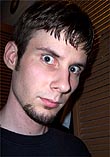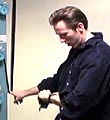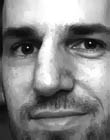|
|
This topic comprises 2 pages: 1 2
|
|
Author
|
Topic: Scans and Photos of film frames
|
|
|
|
|
Stephen Furley
Film God

Posts: 3059
From: Coulsdon, Croydon, England
Registered: May 2002
|
 posted 01-11-2003 03:24 PM
posted 01-11-2003 03:24 PM




Brad, can you post a sample of something you have done this way. What camera do you use, does it auto focus in macro mode, or do you have to focus it? On the models I've seen, cheap ones, the viewing screens are poor, and it's very difficult to see if they are in focus.
( everything has to be cheap for me, I've never got any money, I spend it all on traveling the length of England, or popping over to the US for a few days to see rare film shows. ![[Smile]](smile.gif)
Most film scanners can only take short lengths of film, usually six 8-perf still frames, though there are some that will take continuous lengths. These tend to need the film fed in from one end, not too convienient if you want to scan something in the middle of a 2000 foot roll! Also, they are designed to scan only the frame area, not much good if you want to show perforations, edge markings etc.
Many flatbed scanners can scan film without cutting it, some are equipped as standard, others need an attachment. At one time quality was poor, but more recent models can come close to typical film scanner quality. Resolution is usually lower, but quite good enough for on-screen use, probably not for large printing, from so small a film format. I've got good scanns fron 5x4 transparencies on my flatbed, but would always use my film scanner for 35mm still film.
Sample frame Shows a frame which I scanned from a film strip this way. There was quite a wide black border around the picture, so the original image was probably about 15x20 mm. I supplied high resoultion tiff files to the owner of the site, who downsampled them to the required size and saved jepgs for use on the pages. You don't need high resolution for this sort of use. The text was OCRd from the original lecture notes using the same scanner, a reasonably cheap Epson model. Scanning all 51 frames, plus a couple of extra images, and scanning and OCRing the text took about two hours.
I have also re-photographed onto film with a bellows and slide copier on an SLR camera. This is slow, but useful if ypu need to make slides or negatives for a non-electronic purpose.
I have never tried using a digital camera, because I don't have one, but many of them have quite good macro modes, and so may produce good results.
| IP: Logged
|
|
|
|
|
|
|
|
|
|
|
|
|
|
|
|
|
|
|
|
|
|
|
|
|
|
|
|
All times are Central (GMT -6:00)
|
This topic comprises 2 pages: 1 2
|
Powered by Infopop Corporation
UBB.classicTM
6.3.1.2
The Film-Tech Forums are designed for various members related to the cinema industry to express their opinions, viewpoints and testimonials on various products, services and events based upon speculation, personal knowledge and factual information through use, therefore all views represented here allow no liability upon the publishers of this web site and the owners of said views assume no liability for any ill will resulting from these postings. The posts made here are for educational as well as entertainment purposes and as such anyone viewing this portion of the website must accept these views as statements of the author of that opinion
and agrees to release the authors from any and all liability.
|

 Home
Home
 Products
Products
 Store
Store
 Forum
Forum
 Warehouse
Warehouse
 Contact Us
Contact Us




 Printer-friendly view of this topic
Printer-friendly view of this topic







![[Big Grin]](biggrin.gif)

![[Smile]](smile.gif)





![[thumbsup]](graemlins/thumbsup.gif)







